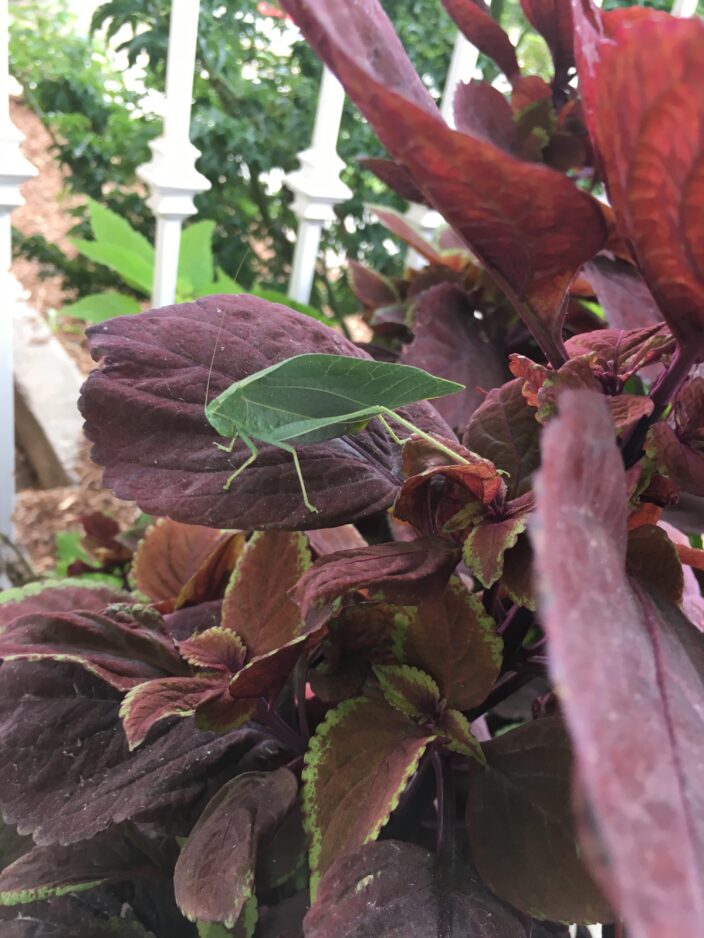Garden Help Desk: What to do if you find katydid eggs in your lawn
- Just like all insects, katydids have many natural enemies. These eggs were parasitized by a tiny wasp that laid her eggs inside the katydid eggs where the wasp larvae will feed on the katydid eggs. When the wasps are mature, they emerge through holes in the eggs.
- An adult katydid’s wings and body so closely resemble leaves that they are almost never noticed in the landscape unless they’re on plants like this coleus where they can’t blend in.
- Seedlings need good care — consistent watering, bright light, the right temperature, and adequate fertilizer. Without those things, young transplants will be stunted and unhealthy.
- Katydids lay their eggs along twigs at the end of the gardening season and the eggs overwinter and hatch in the spring.
- When a katydid egg hatches, it splits open along a seam at the edge of the egg.

Courtesy photo
Just like all insects, katydids have many natural enemies. These eggs were parasitized by a tiny wasp that laid her eggs inside the katydid eggs where the wasp larvae will feed on the katydid eggs. When the wasps are mature, they emerge through holes in the eggs.
I found this while pruning my pear tree. They look like little white lentils in two rows along this twig. Can you identify these from the photo and tell me what I should spray?
These are katydid eggs. Katydids are related to crickets. They’re large, light-green insects; up to 2 inches long when adults. Their wings cover most of their bodies and rest vertically along their backs, like a roof. You’ve probably had katydids in your landscape almost every year, but their color and shape let them blend in with the leaves of plants so well that they are most often overlooked.
Katydids lay their eggs late in the gardening season, most often on twigs like the ones you found on your pear tree. Adult katydids die once cold weather arrives, but the eggs overwinter and hatch in the spring as the new generation.
Katydids feed on plants, but their populations are usually so sparse (because of natural enemies like birds, frogs, snakes and other insects), that feeding damage is minimal and very seldom noticed. Because of this, control measures aren’t generally recommended. Katydids will also eat dead insects or small, slow-moving insects like aphids. If you do see one in your garden, you can leave it there to go about its business without worrying about your plants.
Do you still have the eggs? If you put them back outside, they’ll hatch at the right time in the spring. If you keep the twig and have it indoors, the warmer temperature will hasten the development of the eggs and they could hatch in a few days with the right conditions. You’ll need to provide the hatchlings with a food source and other basic needs if you want to watch them grow. Katydids are popular indoor insect pets, so you’ll have no trouble finding plenty of reliable information online about how to care for the eggs and hatchlings.

Courtesy photo
An adult katydid's wings and body so closely resemble leaves that they are almost never noticed in the landscape unless they're on plants like this coleus where they can't blend in.
I’m starting some seeds in my kitchen, and I’ve heard that pointing a fan at seedlings makes them healthier. After the seeds germinate, how many hours should a fan be directed at them? How much all-purpose (24-18-16) plant food should I add to a gallon of water? How often should I feed my seedlings?
Good air circulation is important for healthy seedlings. They’re susceptible to fungal diseases like damping off and adequate air circulation is part of the good plant care seedlings need. As long as your seedlings have some open space and aren’t confined to a nook or cranny, air circulation should be easy to manage without a fan.
You may have heard that using a fan will help to strengthen your seedlings’ stems and keep the plants sturdier and stockier. The air movement can simulate the breezes that encourage stringer stems, but there is another way you can accomplish the same thing. You can gently brush your hand, or a sheet of paper across the tops of your seedlings. Just a couple of strokes once or twice a day will be enough.
Plants make their own food, and they use fertilizer as part of that process. Your seedlings won’t need fertilizer until they have their first true leaves. After the first true leaves emerge, seedlings can develop pale leaves, poor color, and stunted growth without adequate fertilizer. There should be clear directions on fertilizer product you purchased. It’s easy to over-fertilize small seedlings, so fertilize them at half-strength when you water, but never if the plants are drought stressed.
When it’s time to start hardening off your seedlings you’ll want to cut back on your seedlings to help them toughen up a bit more. Don’t forget to water them, though. It’s easy to forget about your transplants once they’re outdoors. Use your smart phone alarm app to help you remember to check on them twice a day.

Courtesy photo
Seedlings need good care — consistent watering, bright light, the right temperature, and adequate fertilizer. Without those things, young transplants will be stunted and unhealthy.

Katydids lay their eggs along twigs at the end of the gardening season and the eggs overwinter and hatch in the spring.

When a katydid egg hatches, it splits open along a seam at the edge of the egg.







